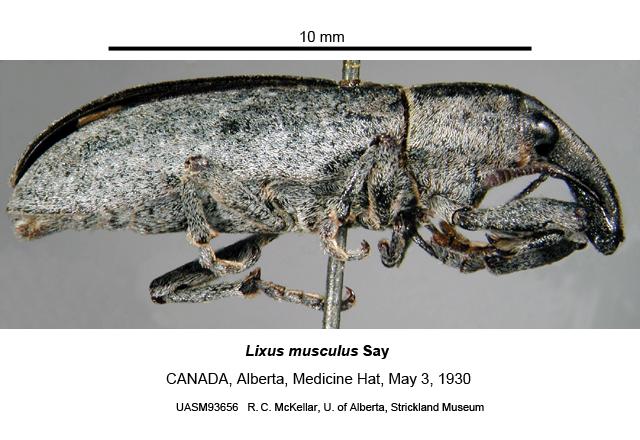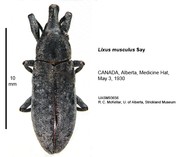Species Details
Lixus musculus
University of Alberta E.H. Strickland Entomological Museum Read more about this collection »
SeasonalityMuseum specimens were taken sporadically throughout the summer and fall months.
IdentificationSay (1831) noted that adult specimens are large (approximately 8.8 mm), with underlying cuticle that is pitch black and covered with numerous short, white hairs. The general body dimensions are fairly ovate in dorsal view (comparatively short and stout), with a tubular, arched rostrum, and a head that is slightly constricted between the eyes. The prothorax is wider than it is long, is strongly rounded at its front, and has fairly rounded sides. The medial angle (at the back of the thorax, along the midline) is depressed, and a broad and shallow longitudinal depression arises just anterior to the medial angle, fading as it heads forward. Punctures on the cuticle are small and dense on the sides of the rostrum's base, comparatively small and dense across the thorax, and larger on elytra, but progressively smaller and constrained to longitudinal grooves near the posterior tip of the elytra. Say's original diagnosis has been supplemented with a few characters suggested by LeConte, (1876) in the identification above.
Scientific Name
Lixus musculus
Habitat
Mesic (moist), semi-aquatic and aquatic habitats (Anderson, 2002; Webster, 1892).
Seasonality
Museum specimens were taken sporadically throughout the summer and fall months.
Identification
Say (1831) noted that adult specimens are large (approximately 8.8 mm), with underlying cuticle that is pitch black and covered with numerous short, white hairs. The general body dimensions are fairly ovate in dorsal…
Say (1831) noted that adult specimens are large (approximately 8.8 mm), with underlying cuticle that is pitch black and covered with numerous short, white hairs. The general body dimensions are fairly ovate in dorsal view (comparatively short and stout), with a tubular, arched rostrum, and a head that is slightly constricted between the eyes. The prothorax is wider than it is long, is strongly rounded at its front, and has fairly rounded sides. The medial angle (at the back of the thorax, along the midline) is depressed, and a broad and shallow longitudinal depression arises just anterior to the medial angle, fading as it heads forward. Punctures on the cuticle are small and dense on the sides of the rostrum's base, comparatively small and dense across the thorax, and larger on elytra, but progressively smaller and constrained to longitudinal grooves near the posterior tip of the elytra. Say's original diagnosis has been supplemented with a few characters suggested by LeConte, (1876) in the identification above.
Life History
Females oviposit individual eggs into notches that they create in stems (Milne and Milne, 1980). Larvae burrow into stems, forming gall-like galleries where they then pupate (Blatchley and Leng, 1916). The adults…
Females oviposit individual eggs into notches that they create in stems (Milne and Milne, 1980). Larvae burrow into stems, forming gall-like galleries where they then pupate (Blatchley and Leng, 1916). The adults emerge to feed on the soft tissues of various plants; often different plants from those used by larvae (Anderson, 1987). There appears to be only one generation per year for this species. Essig (1958) stated that this species was quite similar to Lixus parcus, but was found to inhabit the eastern US as well as Texas and Colorado. This similarity would suggest that it too pupates late within the summer, with adult abundances occurring within the fall.
Conservation
Not of concern.
Diet Info
Some adult specimens in the Strickland Museum have been collected from the foliage of thistles (in the vicinity of Medicine Hat, Alberta). This species has also been reared from the foliage of Polygonum amphibium…
Some adult specimens in the Strickland Museum have been collected from the foliage of thistles (in the vicinity of Medicine Hat, Alberta). This species has also been reared from the foliage of Polygonum amphibium (water smartweed)(Webster, 1892). Otherwise, they are known from knotweed as larvae and pupae, and from a wide range of plants as feeding adults.
Range
American occurrences in Louisiana (O'Brien and Wibmer, 1982; Say, 1831) are supplemented by Strickland Museum records from IL, KS, and NY, as well as a Canadian occurrence in Alberta.
Notes
Males can be distinguished from females in this species by having antennae 1/4 of the way from the tip of the rostrum, as opposed to the females' 1/3rd of the way from the tip (LeConte, 1876).
O'Brien and Wibmer…
Males can be distinguished from females in this species by having antennae 1/4 of the way from the tip of the rostrum, as opposed to the females' 1/3rd of the way from the tip (LeConte, 1876).
O'Brien and Wibmer (1982) treated this species as Incertae Sedis (uncertain placement) within Lixus, and it has somewhat limited literature coverage elsewhere.
References
Author
Anderson, R. S.
Title
American beetles.
Publication Date
2002
Pages
783-785
Author
O’Brien, C. W. and G. J. Wibmer
Title
Annotated checklist of the weevils (Curculionidae sensu lato) of North America, Central America, and the West Indies (Coleoptera, Curculionoidea).
Publication Date
1982
Series Title
Memoirs of the American Entomological Institute
Volume
34
Pages
382 pp.
Author
Webster, F.M.
Title
Food plants of the Lixi.
Publication Date
1892
Series Title
Proceedings of the Entomological Society of Washington
Volume
2
Pages
339-341
Author
Essig, E. O.
Title
Insects and mites of Western North America.
Publication Date
1958
Pages
1050 pp.
Author
Milne L. and M. Milne
Title
National Audubon Society field guide to insects and spiders (North America).
Publication Date
1980
Pages
989 pp
Author
Blatchley, W. S. and C. W. Leng.
Title
Rhynchophora or weevils of North Eastern America.
Publication Date
1916
Pages
682 pp.
Author
Anderson, R. S.
Title
Systematics, phylogeny and biogeography of New World weevils traditionally of the tribe Cleonini (Coleoptera: Curculionidae: Cleoninae).
Publication Date
1987
Pages
740 pp.
Author
LeConte, J. L.
Title
Tribe IV: Cleonini.
Publication Date
1876
Series Title
Proceedings of the American Philosophical Society
Volume
15
Pages
144-160
Author
LeConte, J. L.
Title
Tribe XVIII: Ceutorhynchini.
Publication Date
1876
Series Title
Proceedings of the American Philosophical Society
Volume
15
Pages
267-284
Specimen Information
There are 15 specimens of this Species.
UASM93654 - Lixus musculus
University of Alberta E.H. Strickland Entomological Museum
Place CollectedUnited States: Illinois, Saint Clair county, Cahokia
Collected ByBock, G. W.
Date Collected1991-07-20
UASM93655 - Lixus musculus
University of Alberta E.H. Strickland Entomological Museum
Place CollectedUnited States: Illinois, Saint Clair county, Cahokia
Collected ByBock, G. W.
Date Collected1991-07-20
UASM93656 - Lixus musculus
University of Alberta E.H. Strickland Entomological Museum
Place CollectedCanada: Alberta, Medicine Hat
Collected ByCarr, F. S.
Date Collected1926-05-02
UASM93658 - Lixus musculus
University of Alberta E.H. Strickland Entomological Museum
Place CollectedCanada: Alberta, Medicine Hat
Collected ByCarr, F. S.
Date Collected1926-05-02
UASM93659 - Lixus musculus
University of Alberta E.H. Strickland Entomological Museum
Place CollectedCanada: Alberta, Medicine Hat
Collected ByCarr, F. S.
Date Collected1928-04-30
UASM93660 - Lixus musculus
University of Alberta E.H. Strickland Entomological Museum
Place CollectedCanada: Alberta, Medicine Hat
Collected ByCarr, F. S.
Date Collected1921-05-01
UASM93681 - Lixus musculus
University of Alberta E.H. Strickland Entomological Museum
Place CollectedUnited States: New York, Queens county, Rockaway Beach
Date Collected1908-10-04
UASM93682 - Lixus musculus
University of Alberta E.H. Strickland Entomological Museum
Place CollectedCanada: Alberta, Medicine Hat
Collected ByCarr, F. S.
Date Collected1923-04-29
UASM93683 - Lixus musculus
University of Alberta E.H. Strickland Entomological Museum
Place CollectedUnited States: Illinois, Saint Clair county, Cahokia
Collected ByBock, G. W.
Date Collected1991-07-20
UASM93684 - Lixus musculus
University of Alberta E.H. Strickland Entomological Museum
Place CollectedCanada: Alberta, Suffield
Date Collected1918-05-16
UASM93685 - Lixus musculus
University of Alberta E.H. Strickland Entomological Museum
Place CollectedCanada: Alberta, Medicine Hat
Collected ByCarr, F. S.
Date Collected1921-05-01
UASM93686 - Lixus musculus
University of Alberta E.H. Strickland Entomological Museum
Place CollectedUnited States: Illinois, Saint Clair county, Cahokia
Collected ByBock, G. W.
Date Collected1991-07-20
UASM93687 - Lixus musculus
University of Alberta E.H. Strickland Entomological Museum
Place CollectedUnited States: Kansas, Riley county
UASM93718 - Lixus musculus
University of Alberta E.H. Strickland Entomological Museum
Place CollectedUnited States: New Jersey, Gloucester county, Thorofare
Collected ByWhitehead, D. R.
Date Collected1954-07-07
UASM93657 - Lixus musculus
University of Alberta E.H. Strickland Entomological Museum
Place CollectedCanada: Alberta, Medicine Hat
Collected ByCarr, F. S.
Date Collected1923-04-29



